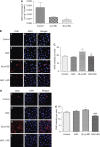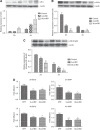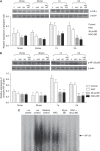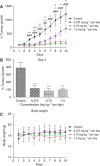Role of reactive oxygen species in brucein D-mediated p38-mitogen-activated protein kinase and nuclear factor-kappaB signalling pathways in human pancreatic adenocarcinoma cells
- PMID: 20068565
- PMCID: PMC2822930
- DOI: 10.1038/sj.bjc.6605487
Role of reactive oxygen species in brucein D-mediated p38-mitogen-activated protein kinase and nuclear factor-kappaB signalling pathways in human pancreatic adenocarcinoma cells
Abstract
Background: In human pancreatic adenocarcinoma, nuclear factor-kappa-B (NF-kappaB) transcription factor is constitutively activated that contributes to the resistance of the tumour cells to induced apoptosis. In our earlier studies, we have shown that brucein D (BD) mediated apoptosis through activation of the p38-mitogen-activated protein kinase (MAPK) signalling pathway in pancreatic cancer cells. This study investigated the function of reactive oxygen species (ROS) in BD-mediated p38-MAPK and NF-kappaB signalling pathways in PANC-1 cells.
Methods: Glutathione and dihydroethidium assays were used to measure the antioxidant and superoxide levels, respectively. The protein expression of p22(phox), p67(phox) and p38-MAPK were examined by western blot. The NF-kappaB activity was evaluated by electrophoretic mobility shift assay.
Results: Treatment with BD depleted the intracellular glutathione levels in PANC-1 cells. Brucein D triggered the activation of NADPH oxidase isoforms, p22(phox) and p67(phox) while enhancing the generation of superoxide. Increases in both intracellular ROS and NADPH oxidase activity were inhibited by an antioxidant, N-acetylcysteine (NAC). Brucein D-mediated activation of p38-MAPK was also inhibited by NAC. However, inhibition of NF-kappaB activity in BD-treated cells was independent of ROS. In vivo studies showed that BD treatment effectively reduced the rate of xenograft human pancreatic tumour in nude mice with no significant toxicity.
Conclusion: These data suggest that BD is an apoptogenic agent for pancreatic cancer cells through activation of the redox-sensitive p38-MAPK pathway and inhibition of NF-kappaB anti-apoptotic activity in pancreatic cancer cells.
Figures







Similar articles
-
Bruceine D induces apoptosis in pancreatic adenocarcinoma cell line PANC-1 through the activation of p38-mitogen activated protein kinase.Cancer Lett. 2009 Aug 18;281(1):42-52. doi: 10.1016/j.canlet.2009.02.017. Epub 2009 Mar 14. Cancer Lett. 2009. PMID: 19286308
-
Interleukin-1alpha enhances IL-8 secretion through p38 mitogen-activated protein kinase and reactive oxygen species signaling in human pancreatic cancer cells.Med Sci Monit. 2005 Oct;11(10):BR343-50. Epub 2005 Sep 26. Med Sci Monit. 2005. PMID: 16192891
-
Brusatol inhibits growth and induces apoptosis in pancreatic cancer cells via JNK/p38 MAPK/NF-κb/Stat3/Bcl-2 signaling pathway.Biochem Biophys Res Commun. 2017 Jun 10;487(4):820-826. doi: 10.1016/j.bbrc.2017.04.133. Epub 2017 Apr 25. Biochem Biophys Res Commun. 2017. PMID: 28455228
-
Signalling mechanisms involved in renal pathological changes during cisplatin-induced nephropathy.Eur J Clin Pharmacol. 2013 Nov;69(11):1863-74. doi: 10.1007/s00228-013-1568-7. Epub 2013 Aug 9. Eur J Clin Pharmacol. 2013. PMID: 23929259 Review.
-
Unraveling the Role of Reactive Oxygen Species in T Lymphocyte Signaling.Int J Mol Sci. 2024 Jun 1;25(11):6114. doi: 10.3390/ijms25116114. Int J Mol Sci. 2024. PMID: 38892300 Free PMC article. Review.
Cited by
-
Apoptosis Triggering, an Important Way for Natural Products From Herbal Medicines to Treat Pancreatic Cancers.Front Pharmacol. 2022 Feb 9;12:796300. doi: 10.3389/fphar.2021.796300. eCollection 2021. Front Pharmacol. 2022. PMID: 35222011 Free PMC article. Review.
-
Ethanolic extract of Brucea javanica inhibit proliferation of HCT-116 colon cancer cells via caspase activation.RSC Adv. 2018 Jan 2;8(2):681-689. doi: 10.1039/c7ra09618f. eCollection 2018 Jan 2. RSC Adv. 2018. PMID: 35538944 Free PMC article.
-
Nickel nanowires induced and reactive oxygen species mediated apoptosis in human pancreatic adenocarcinoma cells.Int J Nanomedicine. 2011;6:1475-85. doi: 10.2147/IJN.S21697. Epub 2011 Jul 13. Int J Nanomedicine. 2011. PMID: 21845039 Free PMC article.
-
Eurycomalactone Inhibits Expression of Endothelial Adhesion Molecules at a Post-Transcriptional Level.J Nat Prod. 2017 Dec 22;80(12):3186-3193. doi: 10.1021/acs.jnatprod.7b00503. Epub 2017 Nov 17. J Nat Prod. 2017. PMID: 29148754 Free PMC article.
-
The anti-migration and anti-invasion effects of Bruceine D in human triple-negative breast cancer MDA-MB-231 cells.Exp Ther Med. 2020 Jan;19(1):273-279. doi: 10.3892/etm.2019.8187. Epub 2019 Nov 12. Exp Ther Med. 2020. PMID: 31853299 Free PMC article.
References
-
- Aggarwal BB (2000) Apoptosis and nuclear factor-kappa B: a tale of association and dissociation. Biochem Pharmacol 60: 1033–1039 - PubMed
-
- Aslan M, Ozben T (2003) Oxidants in receptor tyrosine kinase signal transduction pathways. Antioxid Redox Signal 5: 781–788 - PubMed
-
- Babior BM, Lambeth JD, Nauseef W (2002) The neutrophil NADPH oxidase. Arch Biochem Biophys 397: 342–344 - PubMed
-
- Baeuerle PA, Baltimore D (1988) I kappa B: a specific inhibitor of the NF-kappa B transcription factor. Science 242: 540–546 - PubMed
Publication types
MeSH terms
Substances
LinkOut - more resources
Full Text Sources
Medical

